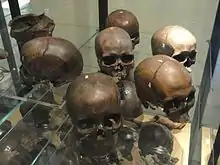Levänluhta
Levänluhta (Finnish: [ˈleʋænˌluhtɑ]; lit. "alga's floodmeadow") or Leväluhta is a spring and prominent archaeological site in the village of Orismala in Isokyrö, Finland. It was used as an Iron Age water graveyard from the 5th to the 8th centuries, containing remains of around 100 individuals.[1] It's one of the oldest known burial sites in Finland with preserved human bones, as the waterlogged environment had contributed to an exceptionally good preservation of the remains.[2]

Ancient DNA of 13 individuals from Levänluhta has been further studied, revealing that most of them had some Siberian-derived genetic ancestry like all Fenno-Ugric peoples, with a slightly closer resemblance to Sami than Finnish people, but the difference was not considerable.[3][4]
References
- "Lammen vesi värjäytyi punaiseksi ja sieltä nousi ihmisten luita – Levänluhdan vainajia ympäröi mysteeri". Ilta-Sanomat (in Finnish). 13 November 2017. Retrieved 3 December 2018.
- "First ancient DNA from mainland Finland reveals origins of Siberian ancestry in region". Science Daily. 27 November 2018. Retrieved 3 December 2018.
- "Muinais-DNA paljastaa: saamelaisissa ja suomalaisissa on samaa siperialaista perimää" (in Finnish). University of Helsinki. 27 November 2018. Retrieved 3 December 2018.
- Sanni Översti et al. Human mitochondrial DNA lineages in Iron-Age Fennoscandia suggest incipient admixture and eastern introduction of farming-related maternal ancestry, 15 November 2019